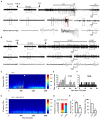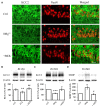M-Calpain Activation Facilitates Seizure Induced KCC2 Down Regulation
- PMID: 30186110
- PMCID: PMC6110871
- DOI: 10.3389/fnmol.2018.00287
M-Calpain Activation Facilitates Seizure Induced KCC2 Down Regulation
Abstract
Potassium chloride co-transporter 2 (KCC2), a major chloride transporter that maintains GABAA receptor inhibition in mature mammalian neurons, is down-regulated in the hippocampus during epileptogenesis. Impaired KCC2 function accelerates or facilitates seizure onset. Calpain, with two main subtypes of m- and μ-calpain, is a Ca2+-dependent cysteine protease that mediates the nonlysosomal degradation of KCC2. Although recent studies have demonstrated that calpain inhibitors exert antiepileptic and neuroprotective effects in animal models of acute and chronic epilepsy, whether calpain activation affects seizure induction through KCC2 degradation remains unknown. Our results showed that: (1) Blockade of calpain by non-selective calpain inhibitor MDL-28170 prevented convulsant stimulation induced KCC2 downregulation, and reduced the incidence and the severity of pentylenetetrazole (PTZ) induced seizures. (2) m-calpain, but not μ-calpain, inhibitor mimicked MDL-28170 effect on preventing KCC2 downregulation. (3) Phosphorylation of m-calpain has been significantly enhanced during seizure onset, which was partly mediated by the calcium independent MAPK/ERK signaling pathway activation. (4) MAPK/ERK signaling blockade also had similar effect as total calpain blockade on both KCC2 downregulation and animal seizure induction. The results indicate that upregulated m-calpain activation by MAPK/ERK during convulsant stimulation down regulates both cytoplasm- and membrane KCC2, and in turn facilitates seizure induction. This finding may provide a foundation for the development of highly effective antiepileptic drugs targeting of m-calpain.
Keywords: KCC2; MAPK/ERK; PTZ; calpain; epilepsy.
Figures






Similar articles
-
Coordinated downregulation of KCC2 and GABAA receptor contributes to inhibitory dysfunction during seizure induction.Biochem Biophys Res Commun. 2020 Nov 12;532(3):489-495. doi: 10.1016/j.bbrc.2020.08.082. Epub 2020 Sep 3. Biochem Biophys Res Commun. 2020. PMID: 32892950
-
Furosemide prevents membrane KCC2 downregulation during convulsant stimulation in the hippocampus.IBRO Neurosci Rep. 2022 Apr 28;12:355-365. doi: 10.1016/j.ibneur.2022.04.010. eCollection 2022 Jun. IBRO Neurosci Rep. 2022. PMID: 35746976 Free PMC article.
-
KCC2 downregulation facilitates epileptic seizures.Sci Rep. 2017 Mar 13;7(1):156. doi: 10.1038/s41598-017-00196-7. Sci Rep. 2017. PMID: 28279020 Free PMC article.
-
GABA receptors as broadcasters of sexually differentiating signals in the brain.Epilepsia. 2005;46 Suppl 5(Suppl 5):107-12. doi: 10.1111/j.1528-1167.2005.01007.x. Epilepsia. 2005. PMID: 15987263 Free PMC article. Review.
-
Role of NKCC1 and KCC2 in Epilepsy: From Expression to Function.Front Neurol. 2020 Jan 17;10:1407. doi: 10.3389/fneur.2019.01407. eCollection 2019. Front Neurol. 2020. PMID: 32010056 Free PMC article. Review.
Cited by
-
The biogenesis of potassium transporters: implications of disease-associated mutations.Crit Rev Biochem Mol Biol. 2024 Jun-Aug;59(3-4):154-198. doi: 10.1080/10409238.2024.2369986. Epub 2024 Jul 1. Crit Rev Biochem Mol Biol. 2024. PMID: 38946646 Free PMC article. Review.
-
Striatal Chloride Dysregulation and Impaired GABAergic Signaling Due to Cation-Chloride Cotransporter Dysfunction in Huntington's Disease.Front Cell Neurosci. 2022 Jan 14;15:817013. doi: 10.3389/fncel.2021.817013. eCollection 2021. Front Cell Neurosci. 2022. PMID: 35095429 Free PMC article. Review.
-
Molecular Mechanisms of Epilepsy: The Role of the Chloride Transporter KCC2.J Mol Neurosci. 2022 Jul;72(7):1500-1515. doi: 10.1007/s12031-022-02041-7. Epub 2022 Jul 12. J Mol Neurosci. 2022. PMID: 35819636 Review.
-
Calpain Inhibitors as Potential Therapeutic Modulators in Neurodegenerative Diseases.Neurochem Res. 2022 May;47(5):1125-1149. doi: 10.1007/s11064-021-03521-9. Epub 2022 Jan 4. Neurochem Res. 2022. PMID: 34982393
-
Calpain fosters the hyperexcitability of motoneurons after spinal cord injury and leads to spasticity.Elife. 2019 Dec 9;8:e51404. doi: 10.7554/eLife.51404. Elife. 2019. PMID: 31815668 Free PMC article.
References
-
- Araujo I. M., Gil J. M., Carreira B. P., Mohapel P., Petersen A., Pinheiro P. S., et al. . (2008). Calpain activation is involved in early caspase-independent neurodegeneration in the hippocampus following status epilepticus. J. Neurochem. 105, 666–676. 10.1111/j.1471-4159.2007.05181.x - DOI - PubMed
LinkOut - more resources
Full Text Sources
Other Literature Sources
Research Materials
Miscellaneous

